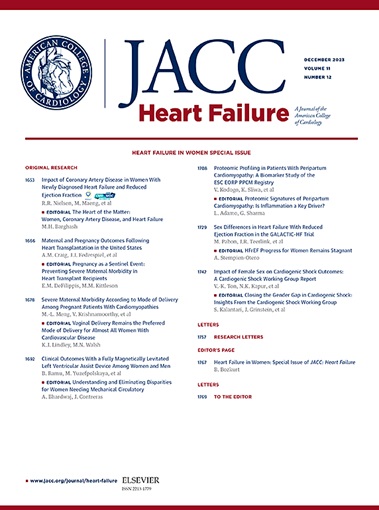Effects of Atrial Fibrillation Ablation for Heart Failure With Preserved Ejection Fraction
IF 10.3
1区 医学
Q1 CARDIAC & CARDIOVASCULAR SYSTEMS
引用次数: 0
Abstract
Background
Atrial fibrillation (AF) ablation is Class I recommendation in selected heart failure (HF) patients with reduced ejection fraction; less is known in heart failure with preserved ejection fraction (HFpEF).
Objectives
The aim of this study was to investigate the effects of AF ablation in patients with HFpEF.
Methods
The CABANA (Catheter Ablation vs Antiarrhythmic Drug Therapy for Atrial Fibrillation) trial randomized patients with cardiovascular risk factors for stroke to AF ablation vs drug therapy. The presence of a high likelihood of HFpEF at enrollment was determined by a modified H2FPEF score of ≥6. Treatment effects of baseline HFpEF likelihood on the AF ablation for death and cardiovascular admission, AF recurrence, and functional status were assessed.
Results
A total of 1,763 patients were included in the analysis. A high modified H2FPEF score (55% of the entire cohort) resulted in a significant treatment effect modulation (P for interaction = 0.027), with a lower risk for cardiovascular hospitalization or death in patients with a high likelihood of HFpEF (HR: 0.82 [95% CI: 0.69-0.98]; P = 0.025), but not in patients without (HR: 1.00 [95% CI: 0.82-1.22]; P = 0.987). Although patients with a high likelihood of HFpEF were at a higher risk for AF recurrence, the greatest treatment effect of AF ablation on AF recurrence was observed in patients with a high likelihood of HFpEF (P for interaction = 0.035). In a sensitivity analysis in a subset of patients with echocardiographic evidence of HFpEF (n = 225), a similar treatment interaction was found.
Conclusions
In patients undergoing AF ablation, the presence of underlying HFpEF (either by HFpEF probability or defined by echocardiography) was associated with a larger benefit with AF ablation on clinical outcome, AF recurrence, and functional status. (Catheter Ablation vs Antiarrhythmic Drug Therapy for Atrial Fibrillation [CABANA]; NCT00911508)
房颤消融对保留射血分数的心力衰竭的影响
背景:对于有射血分数降低的心衰(HF)患者,心房纤颤(AF)消融是一级推荐;对于保留射血分数(HFpEF)的心力衰竭则知之甚少。目的研究心房颤动消融对HFpEF患者的影响。方法CABANA(心房颤动导管消融与抗心律失常药物治疗)试验将卒中心血管危险因素患者随机分为心房颤动消融与药物治疗两组。通过修改后的H2FPEF评分≥6来确定入组时HFpEF存在高可能性。评估基线HFpEF可能性对房颤消融死亡、心血管入院、房颤复发和功能状态的治疗效果。结果共纳入1763例患者。高修正的H2FPEF评分(占整个队列的55%)导致显著的治疗效果调节(相互作用P = 0.027),高可能性的HFpEF患者心血管住院或死亡的风险较低(HR: 0.82 [95% CI: 0.69-0.98];P = 0.025),但没有感染的患者没有(HR: 1.00 [95% CI: 0.82-1.22];P = 0.987)。虽然HFpEF高可能性患者的AF复发风险更高,但在HFpEF高可能性患者中观察到AF消融对AF复发的最大治疗效果(相互作用P = 0.035)。在一组超声心动图证据为HFpEF的患者(n = 225)的敏感性分析中,发现了类似的治疗相互作用。结论:在接受房颤消融的患者中,存在潜在的HFpEF(通过HFpEF概率或超声心动图确定)与房颤消融在临床结局、房颤复发和功能状态方面的更大益处相关。导管消融与抗心律失常药物治疗心房颤动[CABANA];NCT00911508)
本文章由计算机程序翻译,如有差异,请以英文原文为准。
求助全文
约1分钟内获得全文
求助全文
来源期刊

JACC. Heart failure
CARDIAC & CARDIOVASCULAR SYSTEMS-
CiteScore
21.20
自引率
2.30%
发文量
164
期刊介绍:
JACC: Heart Failure publishes crucial findings on the pathophysiology, diagnosis, treatment, and care of heart failure patients. The goal is to enhance understanding through timely scientific communication on disease, clinical trials, outcomes, and therapeutic advances. The Journal fosters interdisciplinary connections with neuroscience, pulmonary medicine, nephrology, electrophysiology, and surgery related to heart failure. It also covers articles on pharmacogenetics, biomarkers, and metabolomics.
 求助内容:
求助内容: 应助结果提醒方式:
应助结果提醒方式:


